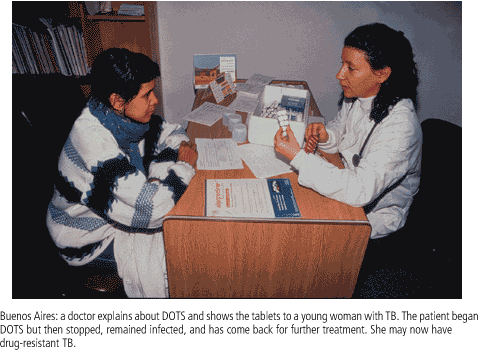A new TB drug by 2010 - or sooner?

The last drug developed for TB was rifampicin, which first came into wide use in 1971 - 72. But the 30-year intermission may soon be over: on the starting blocks are fluororoquinolones, a class of drugs that are effective against several mycobacteria. TB is caused by Mycobacterium tuberculosis. "Fluoroquinolones might be quite strong for TB" says Mario Raviglione of Stop TB and WHO.
Earlier this year, researchers led by P. R. Naranayan at the Tuberculosis Research Centre in Chennai, India, reported in the Indian Journal of Tuberculosis, 2002; 49: 27-38 that they had successfully treated patients in just four months by replacing one of the four standard anti-TB drugs, ethambutol, with a fluoroquinolone called ofloxacin. The researchers treated patients with daily doses of isoniazid, rifampicin, pyrazinamide, and ofloxacin for three months, followed up with twice-weekly doses of isoniazid and rifampicin for an additional one or two months. Not only were the cure rates greater than 98%, but relapse rates were less than 5% in the two years following treatment.
"If this study can be confirmed, perhaps with better, more powerful fluoroquinolones, it would already be a major advantage to TB control," says Raviglione. "This could come in three to five years."
"Ofloxacin is just a launching pad as replacement for ethambutol" in the standard DOTS therapy, says Bernard Fourie, Director of the Tuberculosis Research Lead Programme in South Africa. "Ofloxacin is essentially setting the scene for bigger work on more exciting fluoroquinolones such as moxi- floxacin, gatifloxacin and levofloxacin."
Rifamycins are another class of antibiotics that TB experts have their eyes on. One of the compounds, rifampicin, has been a cornerstone of TB treatment for decades. Now researchers are interested in some of its molecular relatives including rifabutin from Pharmacia Corporation, and rifapentine, which is manufactured by Aventis Pharmaceuticals and approved for TB in the United States.
The newest class of broad-spectrum antibiotics, oxazolidinones, also show "very interesting activity against M. tuberculosis," says Giorgio Roscigno, Director of Strategic Development for the Global Alliance for TB Drug Development. Pharmacia Corporation recently received approval for linezolid, an oxazolidinone, for treating specific acute bacterial infections. Roscigno and other experts hope related compounds will be studied for TB as well.
A compound dubbed PA-824 is also stirring up excitement. A member of a novel class of substances known as nitroimidazopyrans, PA-824 attacks M. tuberculosis on two fronts. It disrupts protein synthesis and cripples the ability of the pathogen to make a fatty acid needed for building the cell wall.
In laboratory tests, the compound's one-two punch appears to be lethal to most versions of the microbe. "Its mechanism of action is sufficiently different from that of any other anti-TB drug that PA-824 kills drug-resistant cells, even strains resistant to six or seven anti-TB medications, at exactly the same level as it kills sensitive strains," says Bryan Walser, vice-president of corporate strategy at Chiron Corporation, a California-based pharmaceutical company. "And it kills fast because it also targets non-growing bacteria unlike some other antibiotics that require the M. tuberculosis to be growing. While other drugs must be used for six months, PA- 824 is likely to act more quickly than that."
Its ability to kill both the active and the inactive forms of the pathogen, as well as multidrug-resistant strains, suggests that PA-824 could be the all-in-one drug every one is looking for. But despite its potential, further development of PA-824 was "on ice" until last February, says Craig Wheeler, president of Chiron's biopharmaceuticals division.
That's when the Global Alliance and Chiron announced they were joining forces to push PA-824 further along the development pipeline. Under the agreement, the Global Alliance will complete preclinical testing and move the compound through phase II trials, which will test PA-824 on a small number of TB patients. If the results are good at that point, Chiron can "opt back in" to the development, reimburse the Global Alliance for the development costs, and negotiate for rights to the potential drug in developed countries. Regardless of Chiron's decision, the Global Alliance would keep full rights to the drug in developing countries to ensure that the compound will be affordable and available where it is needed most.
The agreement keeps a potential "gold medal" compound in development. Only one in 10 molecules ever makes it to the market, and the cost of getting it there is an estimated US$ 300 - 500 million. So relieving a pharmaceutical company of some of the financial risk, while keeping a promising molecule in development is a "win/win," says Wheeler. "Chiron would not have taken PA-824 forward on its own."
Meanwhile, some pharmaceutical companies are scouring their chemical compound collections for molecules with anti-TB activity. For example, the AstraZeneca research facility in Bangalore, India, is in the second year of a five- year programme to find a lead compound for further development. "We have screened one million compounds and have many 'hits'," says Anand Kumar, director of the Astra Zeneca Research Foundation. "By the end of this year, we will have selected them down to the few compounds that we feel are most suitable for developing further."
Other researchers are turning to nature for novel anti-TB molecules. Botanists and biochemists at the University of Durban in South Africa have isolated three compounds from native plants that show "significant" anti-TB activity. The identity of the compounds is still under wraps, but they have survived major steps in early drug development, says Fourie. "We're very confident this work is not going to be futile."
The mood itself is infectious. "What you're sensing with the scientists is not only an excitement about the field," says Maria Freire, Chief Executive Officer of the Global Alliance for TB Drug Development, "but the sense that a new therapeutic drug, by 2010, actually can happen." 
Charlene Crabb, Paris
